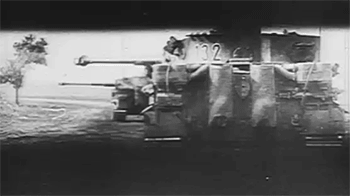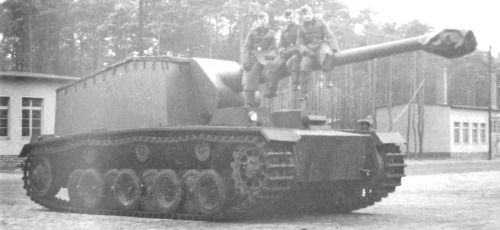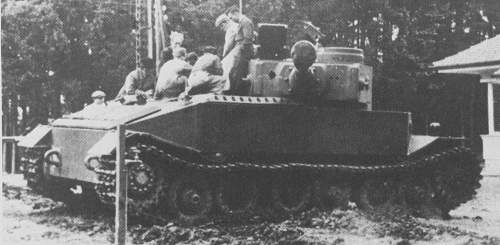Introduction
The Panzerkampfwagen VI "Tiger" which was the Wehrmacht’s first mass-produced heavy tank, has always been steeped in myth and legend. The Tiger had a truly colossal appearance and was able to dominate the battlefield. Produced from 1942 to 1944 by only one manufacturer, Henschel, the Tiger had been deployed at most fronts and proved very effective against almost all kinds of Allied armor. The Tigers powerful 8.8cm KwK 36 L/56 gun and thick armor propelled the tank into its primary status as one of the most powerful tanks of WW2.
A Leibstandarte Division Tiger fires its main gun into enemy position to provide suppressive counter fire near Petrivka, Ukraine, March 1944. This was one of the new replacement tanks that were delivered in February and has a small, black number '2' as a tactical identifier, on the forward art of the turret and on the rear turret stowage box. The vehicle belongs to 13./SS-Panzer-Regiment 1, equipped with Tiger tanks, and which formed part of the Leibstandarte Division, that was established at Fallingbostel at the end of November 1942.
The Tiger, however, also had disadvantages. The first deployment of four Henschel Tigers by the 502nd Heavy Panzer Battalion in Leningrad, on the 29th August 1942, was not much of a success because three of the four deployed Tigers broke down and had to be withdrawn. Two of them broke down because of transmission failure and one due to engine damage. Only the fourth Tiger tank, the command tank, remained operational. Like many other German armored vehicles, its baptism of fire was hindered by teething problems. The lack of sloped armor, the complicated and expensive manufacturing, the underpowered engine and the failure-prone engineering: all these made the Panzerkampfwagen VI a temperamental tank with huge upkeep costs and high maintenance. As a result, many of the initial Tiger Ausführungen were lost due to technical failures.
On the Allied side, soldiers developed a kind of “Tiger-Phobia”, partly thanks to German propaganda. As soon as a Tiger was sighted by the Brits, it was reported to the commander of the area The number of reported sightings of Tigers were far higher than the Tigers on the ground. This was partly due to the similarity in silhouette between the Tiger and the Panzer IV when seen from afar.
Two Tigers from schwere Panzer-Abteilung 503 as seen through the Tiger driver’s vision visor during an advance in the summer of 1943.
Soon after various sightings of Tigers, Field Marshall Montgomery himself forbade publication of reports about the Tiger knocking out Allied tanks, in order to maintain the morale of his troops. It was reported that a single Tiger was able to shoot for almost an hour without Allied reaction because no British tank crew was brave enough to engage it. There was even a myth circulating that at least 5 M4 Shermans were needed to kill a Tiger, and even then only one of them would return. In the end, it proved to be mostly myth. Whilst the Tiger had a clear advantage in longer distances (500m - 3,8 km), two Shermans would have been sufficient in ranges below 500m.
Tiger ‘S24’ from the 13./SS-Panzer-Regiment 1 of the Leibstandarte Division in late December 1943 during one of the company’s numerous road marches from one crisis area to another.
Development
The very first steps towards producing an operational Tiger were made in 1937, when the Heereswaffenamt ordered a successor for the Panzerkampfwagen IV. Orders for designs were given to Henschel, Daimler-Benz, Porsche and MAN. Whereas the drafts of MAN and Daimler-Benz led to the Panther later on, Henschel’s and Porsche’s designs were rather oriented to a heavier tank. With the name Durchbruchwagen (short meaning: Breakthrough-Vehicle in the following abbreviation: DW), the first predecessor of the Tiger was produced. Whilst prototype DW1 did not have a gun, DW2 was equipped with the short barreled 7.5 cm KwK 37 L/24 gun, which was also found on other German AFVs. The development was cancelled, when the western campaign started. Plans for introducing a heavy tank were resumed, when the Germans were facing the superior T-34 and KV-1 tanks on the eastern front.
Further development led to the VK.3001. Compared to DW1 and 2, VK.3001 had a better 400 hp engine, better transmission and was altogether a better version of the DW.
As in many other development decisions, Hitler was deeply involved. On the 25.05.1941 Hitler demanded development of a self-propelled gun carriage for guns with the caliber of 10.5 cm and 12.8 cm. Both of the built prototypes 12.8 cm VK.3001 with the nickname “Sturer Emil” were used later on in the eastern front. The demands of a heavy tank were not sufficiently fulfilled when it came to armor (50mm) and speed (20 km/h).
The Panzerselbstfahrlafette (Pz.Slf.) V, better known as the Sturer Emil, was an experimental self-propelled gun developed by the Germans in 1941. Armed with a massive 128mm gun, it could penetrate T-34s at over 4,500 meters. Pictured here is the first of only two that were built, seen here in Wüstorf.
The exact features of the first heavy tank were unclear at this point. The Heereswaffenamt demanded a tank with a 6 or 7 cm gun, so that the tank would not become too heavy and costly. Hitler himself wanted the Acht-Achter, the common 8.8 cm AA gun, which had already shown its immense potential as an anti-tank gun.Henschel and Porsche were both assigned to present their prototypes on the 20th of April 1942, Hitler's 53rd birthday in the Nibelungenwerk. When Hitler was introduced to both prototypes, everyone was convinced that Porsche’s Tiger was the superior model. While Hitler spent 30 minutes talking about Porsche’s VK.4501 prototype, the VK.3601 was mostly ignored.
Panzerkampfwagen VK. 4501 (P).
Further testing in the following months has shown that, despite all doubts, Henschel’s Tiger was superior, considering off-road capabilities and reliability and accordingly, Henschel were given the contract to produce all further Tiger tanks. Additional improvements of the Tiger resulted in the Tiger Ausführung E, which was produced from August 1942 onwards. It is important to note that Tigers were often improved while in production. As a consequence, many Tigers could not be repaired in the same way that other marks of the same model could be repaired, resulting in difficult and expensive maintenance.
Porsche had already built 100 chassis of the tanks when they lost the contract, with some used for the prototypes. Using the 90 unused chassis, Porsche was assigned to build a heavy tank destroyer which would result in the Panzerjäger Tiger (P), which was named "Ferdinand" after Ferdinand Porsche, and was later renamed as the "Elefant", after some slight improvements had been made.
All in all, development and production costs for the Tiger were estimated at approximately 500.000.000 Reichsmarks. If you examine the outcome of the war, it raises the question whether Fortschritt durch Technik (advantage through technology) may not have been exactly what the Wehrmacht needed. Unchallenged is the efficiency of German industry, which produced the first experimental armored fighting vehicles out of nothing within 12 months, thereby delivering the army a potent tank, which was able to participate in every tank-to-tank battle with good chances of success, but general shortage of materials and the impact of Allied air superiority prevented a sufficient supply of them to the tank battalions.
Tiger tanks were feared by the Allies, but they were scarce and extremely valuable tanks, which did not achieve sufficient numerical advantage. Today’s war historiography often overlooks that in reality, less than 2000 Tiger tanks were built, compared to the sheer mass of enemy tanks (more than 49.000 Shermans, for example). By comparison, 2000 is a truly modest number.
The fact that the Tiger’s solid reputation is still ongoing, is tribute to the capacity of the designers, the capacity of the industry that created them and to the tank crews, who tried to stand against the overwhelming numerical superiority of the Allied forces.
British soldier hiding from the rain under an overturned Tiger tank in Italy, 1944.
Variations
Elefant/Ferdinand
The order to reconstruct the Porsche chassis, with the purpose of building a heavy tank hunter, was given on the 26.09.1942. Hitler ordered a highly armored (200mm front armor), super heavy tank destroyer with the long 8,8 cm L/71 barrel, which had to have exactly these specifications and which accordingly resulted in a slow speed of approximately 20 km/h. First deployed in Operation Zitadelle, technical failures were high, munitions were scarce, and the Ferdinand had no close-combat options at all. Most of the deployed vehicles were lost to enemy action or had to be abandoned, because fuel was simply non-existent.But although the losses were high, the Ferdinand scored very high kill counts. The 653rd Heavy Tank Destroyer Bataillon claimed it had destroyed 320 enemy vehicles during the battle of Kursk, while only losing 13 Ferdinands.
After Kursk, the remaining Ferdinands were outfitted with a ball-mounted MG34 in the front of the hull, based on what the crews experienced during the battle of Kursk. Also, the frontal armor was thickened and the tracks were widened, which increased the weight of the vehicle from 65 to 70 tons. Called the "Elefant" from now on, by order from Hitler, the remaining vehicles saw action on the Eastern Front and in Italy.
Jagdtiger
While construction of the “Tiger B” was still ongoing, development of a super-heavy tank destroyer - “Jagdtiger” - had started. In cooperation with Krupp, the tank was supposed to have a long 12.8 cm barrel and a permanent superstructure. A wooden model was presented in 20.10.1943. Presentation of the first functioning tank was made in 20.04.1944. The battle weight with a six man crew, 40 rounds of ammo and 860 litres fuel was about 75.2 tons.
As a result of the thick armor (250mm front, 80mm sides) and the long barrel, the Jagdtiger was the heaviest tank of all nations at that time, its weight hopelessly overburdening the 700 hp Maybach engine. A total of 150 Jagdtigers was planned initially, with a monthly production of about 50 Jagdtigers. The monthly quota was never reached. When most of the steel mills were destroyed in early 1945, Hitler ordered the existing Jagdtiger chassis’ to be equipped with the 8.8 cm PaK 43/3. 60 entities of the “Panzerjäger Tiger für PaK 43/3 (Sd.Kfz. 195)” were built.
Jagdtiger abandoned in Neustadt Rhineland-Palatinate, Germany Friday, 23 March 1945.
Sturmtiger
On the 05.08.1943 Hitler was presented the proposal for construction of a “Tiger-Mörser” equipped with the “38cm Wurfgerät” of the Kriegsmarine. Hitler accepted Guderian’s proposal and ordered a prototype to be developed. On the 21.09.1944, the 7th Sturmtiger was delivered. Hitler attached great importance to the Sturmtiger for special operations, such as bunker busting. Sturmtigers were able to carry 14 shells on their own, although invariably an additional SwS was assigned to carry more ammo. The tank had its own crane to help resupply, because the shells weighed about 365 kg. Its “Raketenwerfer 61, 38 cm L/5,4” could shoot about 6 km far into the distance. The first Sturmtigers were deployed in Warsaw, late summer 1944.
Sturmtiger shooting at buildings in Poland.
"Advantage through technology" - The right approach?
By the end of 1944, serious doubts had been raised as to whether the Tiger class was not too heavy and immobile for tactical use. Even Henschel’s engineers claimed that the “Panther” tank was much better suited for mass-production and was a better tank, taking into account tactical purposes. With regard to savings measures in early 1945, considering working hours per tank and supply bottlenecks, the demand for a lighter and easily producible 35t tank became clear.
On the other hand, after the Allies landed in France, hope for victory had mostly vanished and most “Panzer-Bauprogramme” had stopped. There is no doubt that with the development of the Tiger class, limits had been reached regarding dimension and weight.
Despite mechanical difficulties, there was no doubt the Tiger was an extraordinary tank. In particular, Tiger tank crews considered themselves to have a superior advantage in terms of armor and armament, when fighting against T34s, Shermans and other Allied tanks, which raised their overall morale. In contrast, there remained the sensivity and weakness of the motor and drive, excessive ground pressure and understated weight-to-power ratio.
As much as the Tiger became a legend, more light, mobile and reliable tanks would have served the troops better.





















 cblanco ★
cblanco ★  보드카 중대
보드카 중대  VonManteuffel
VonManteuffel  Heartless Jäger
Heartless Jäger 